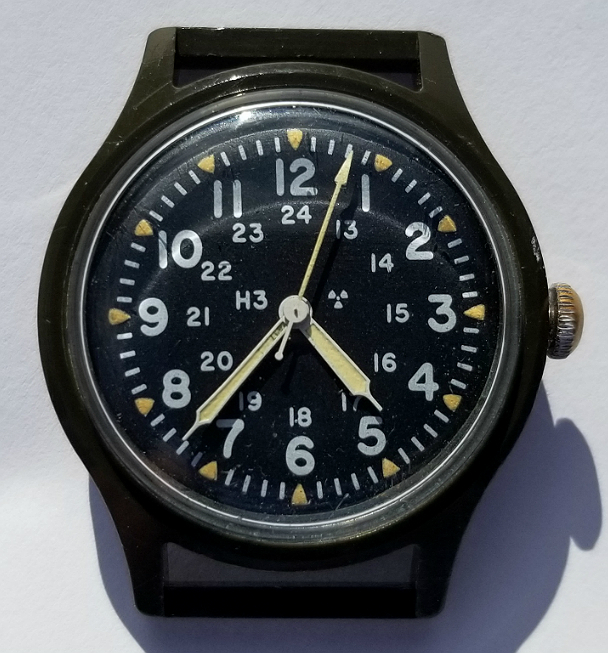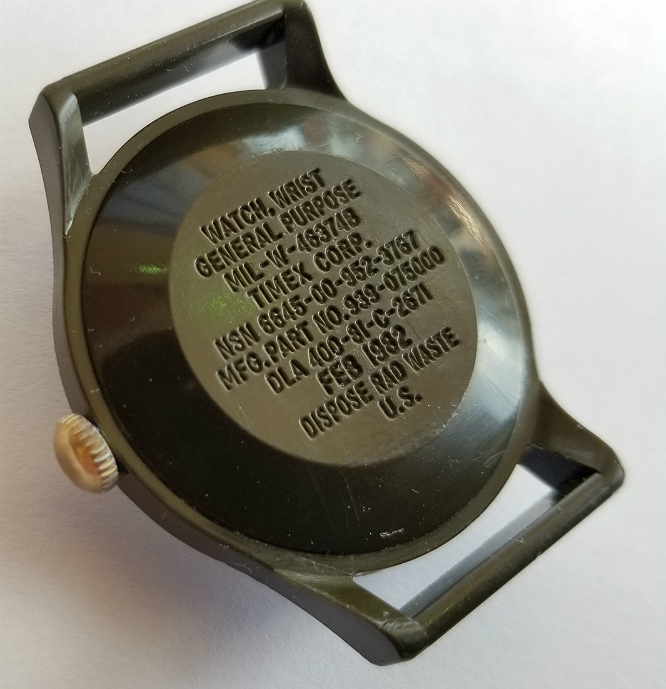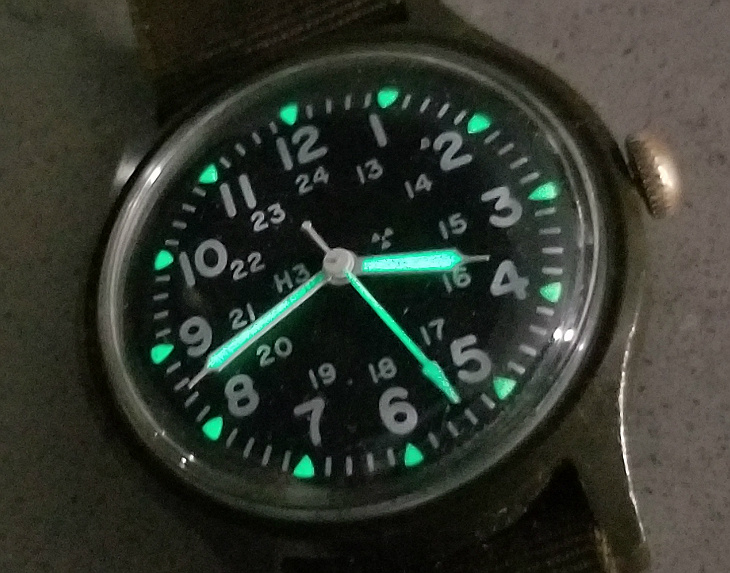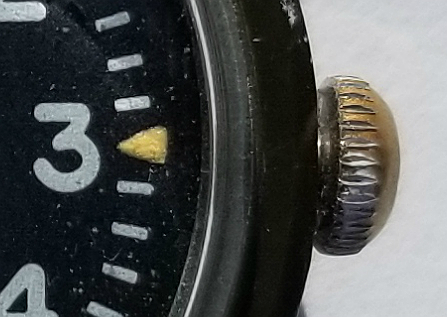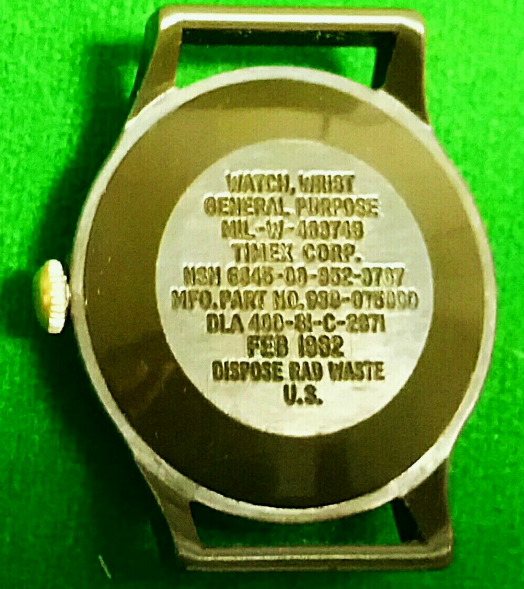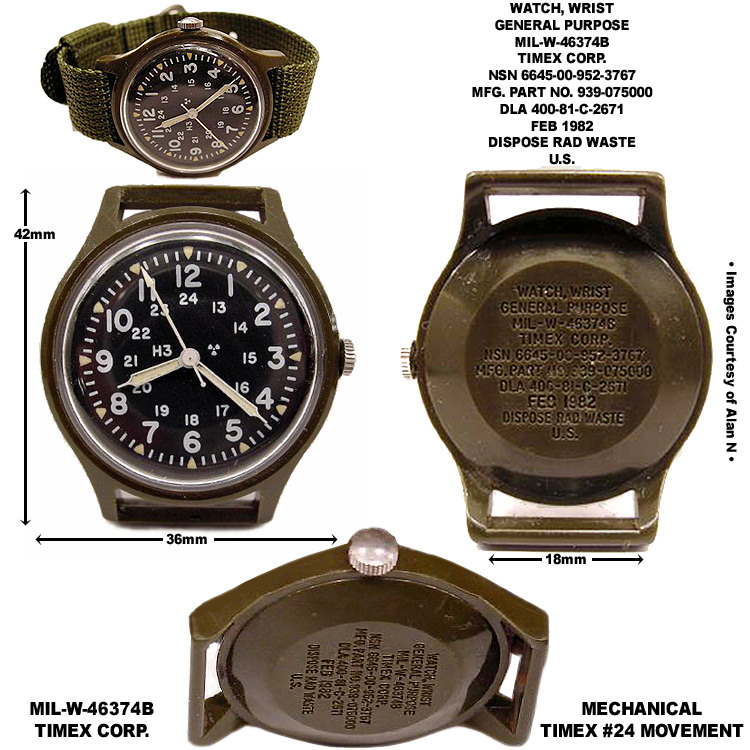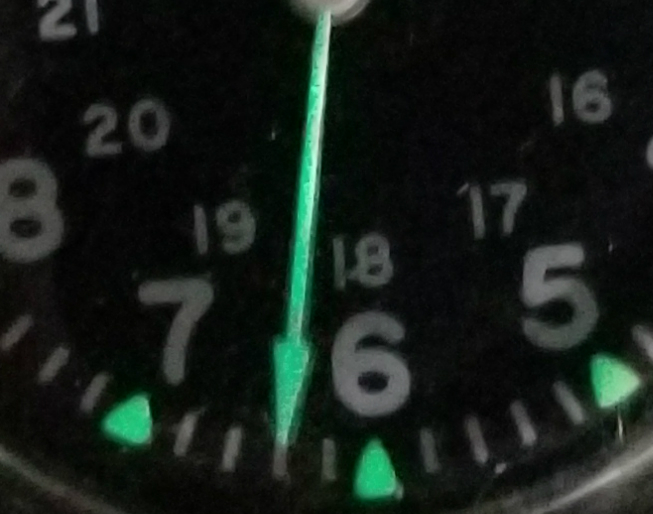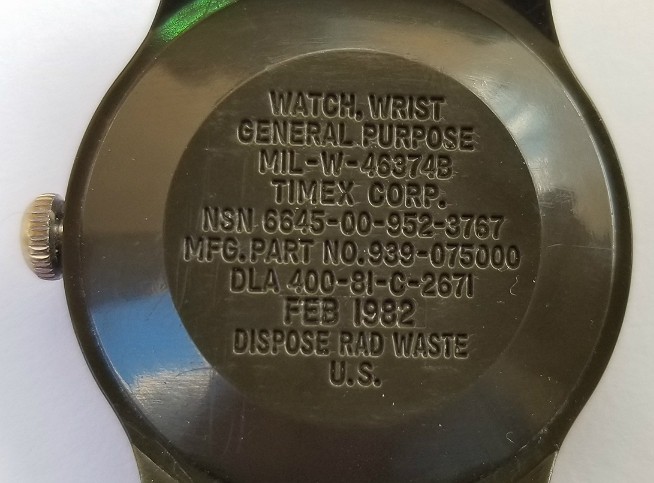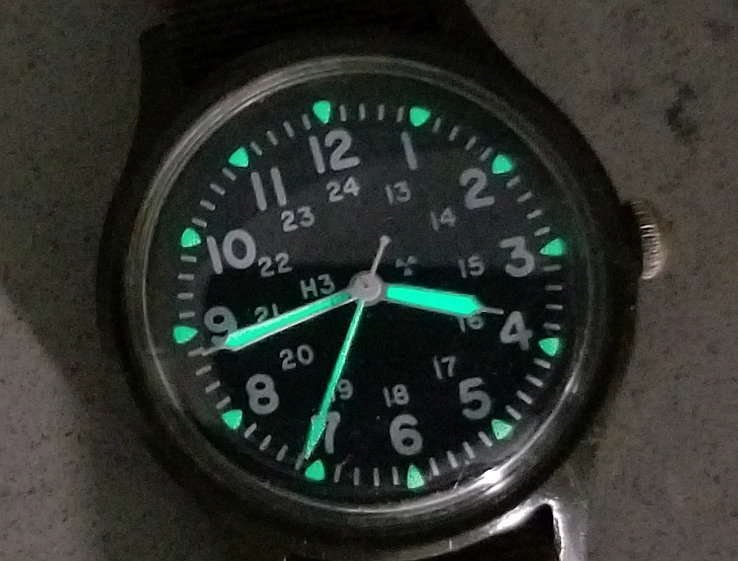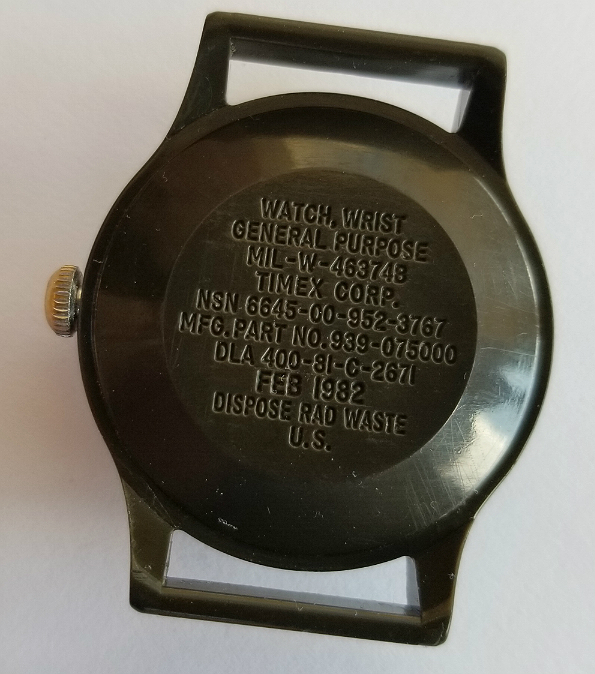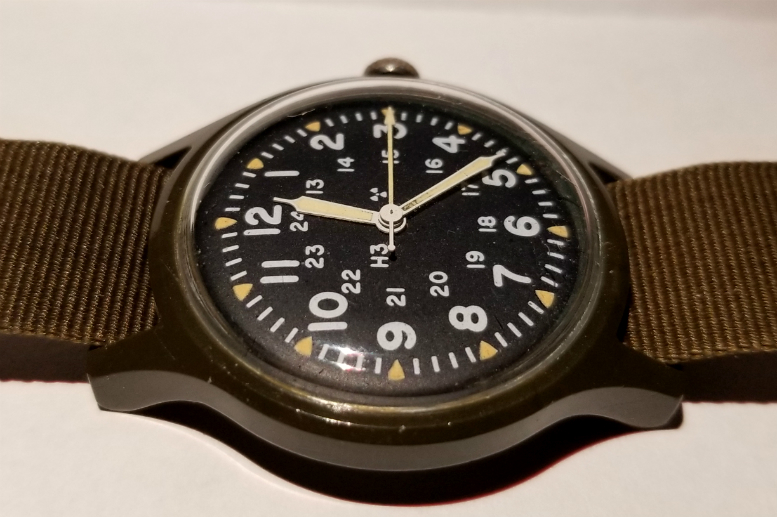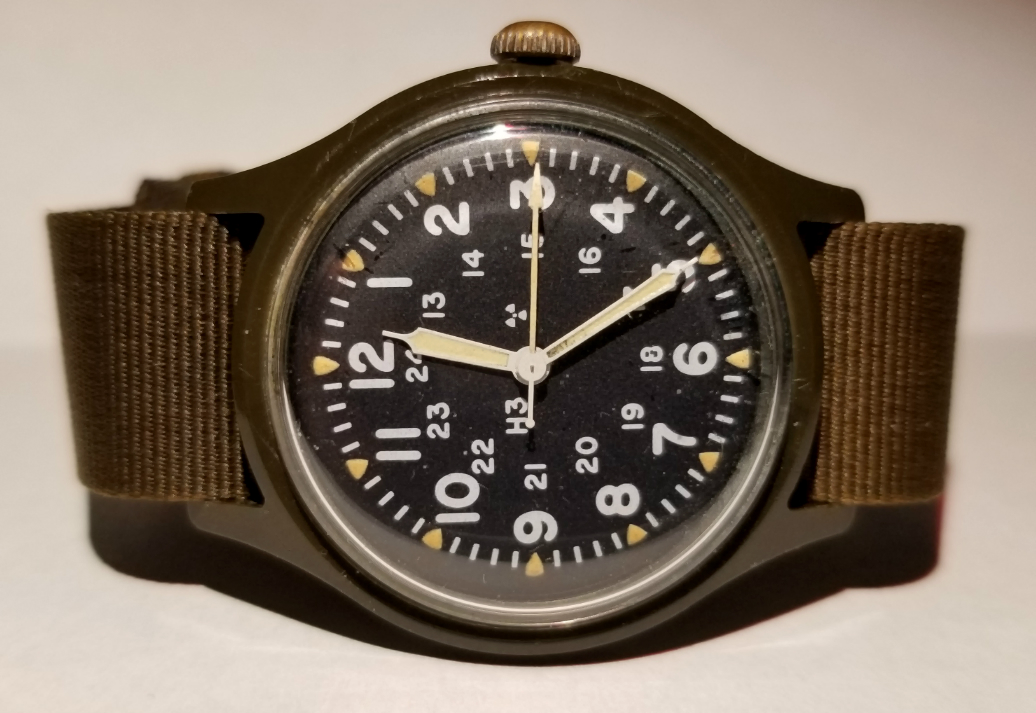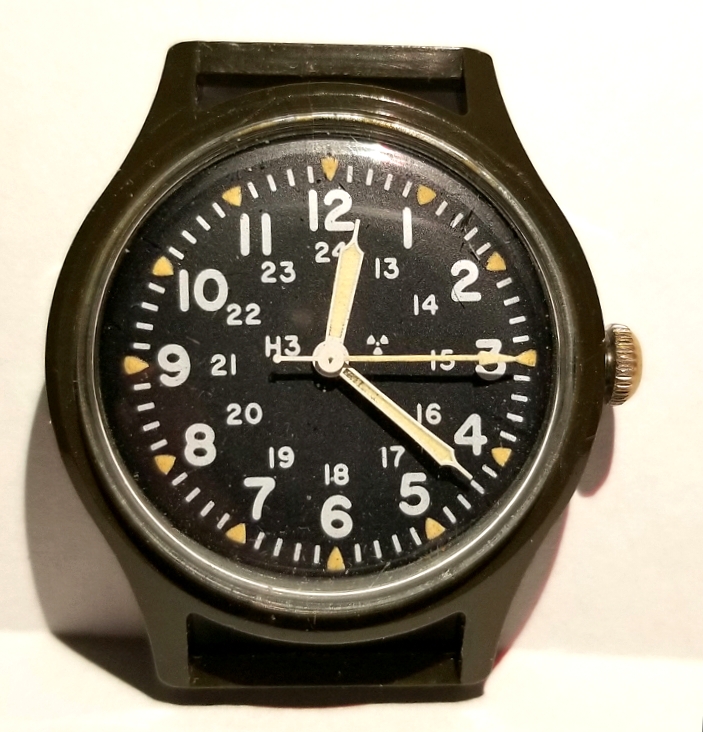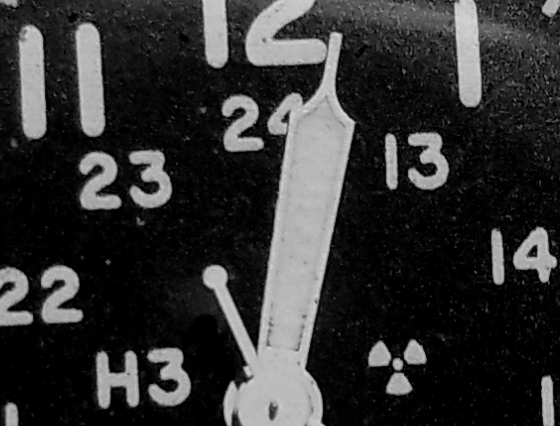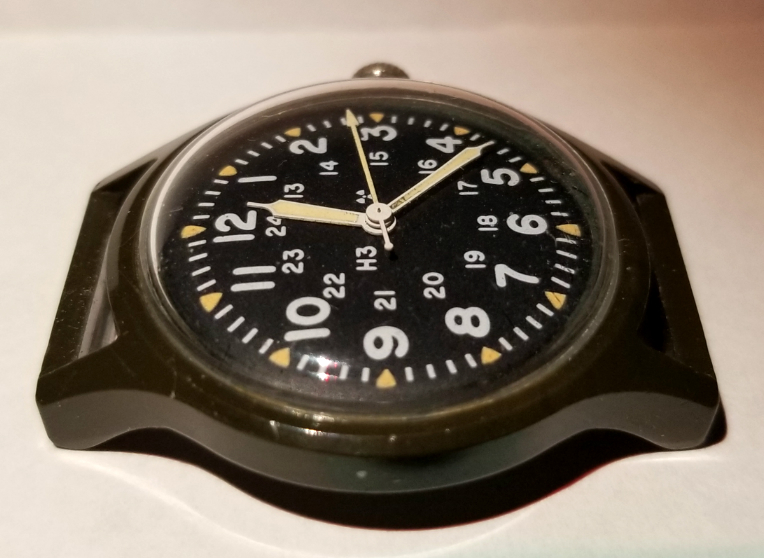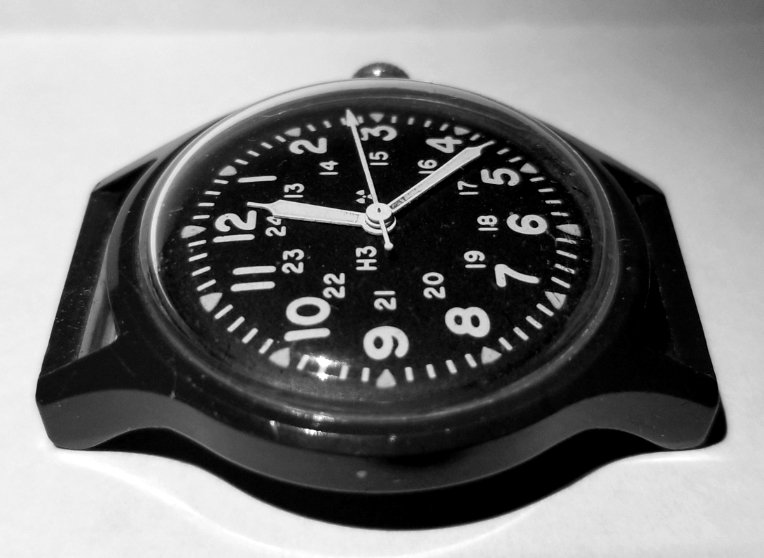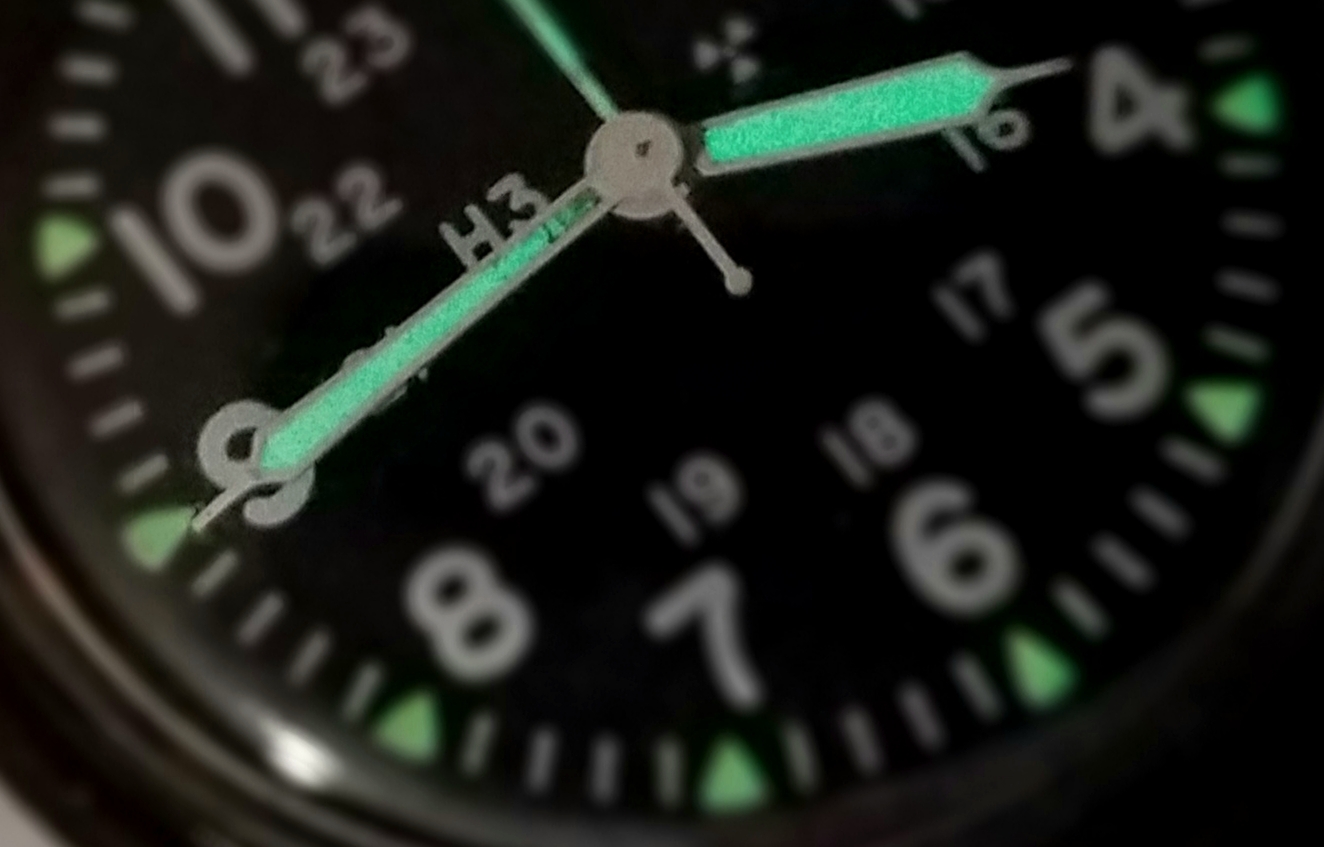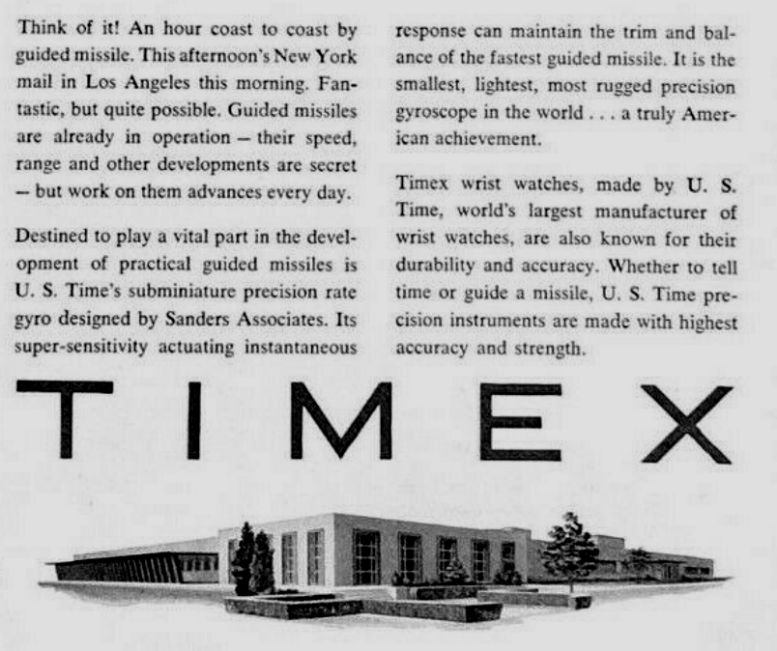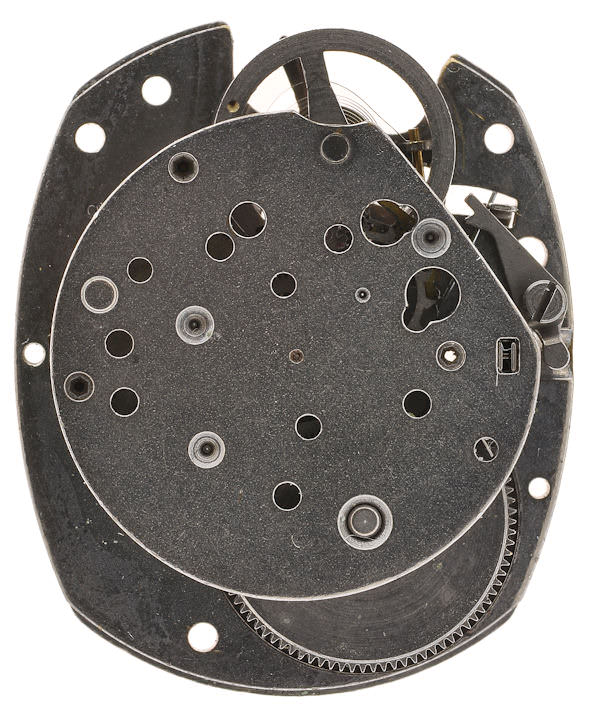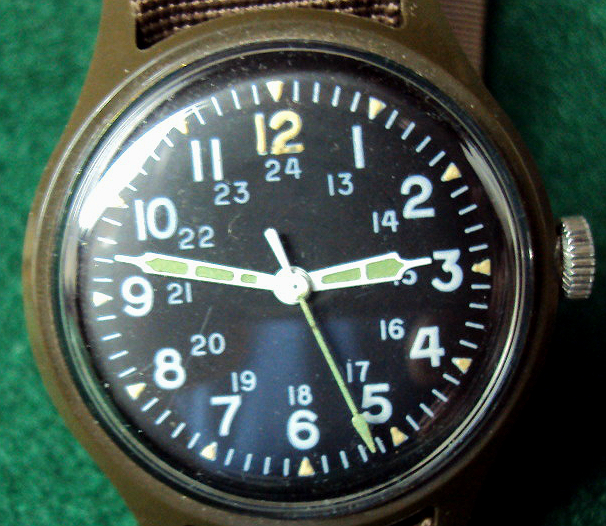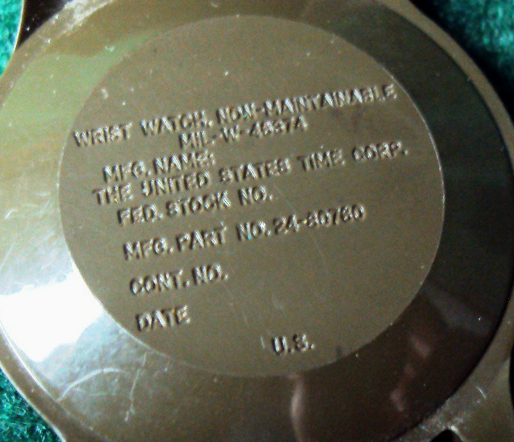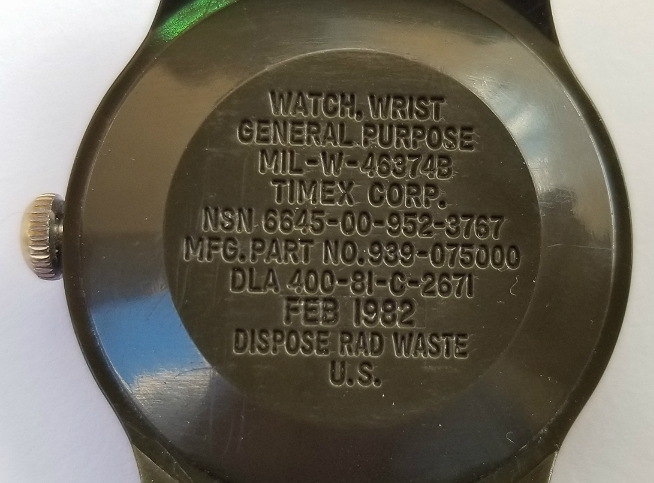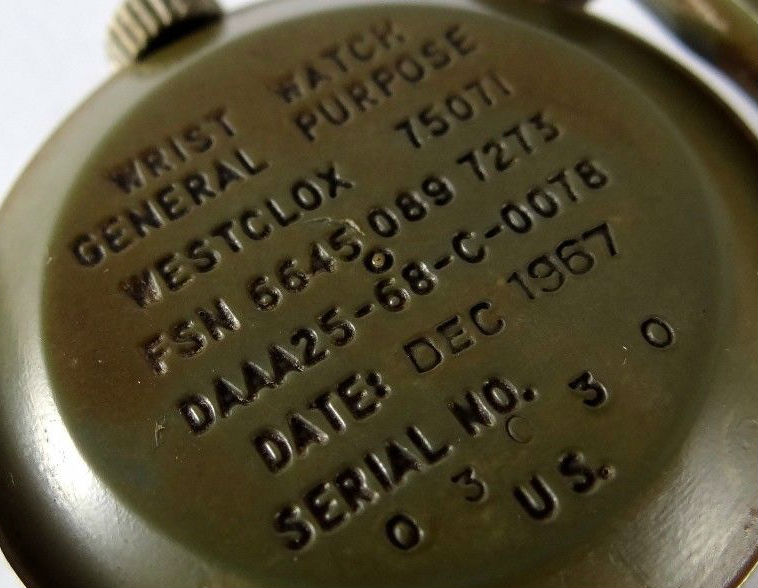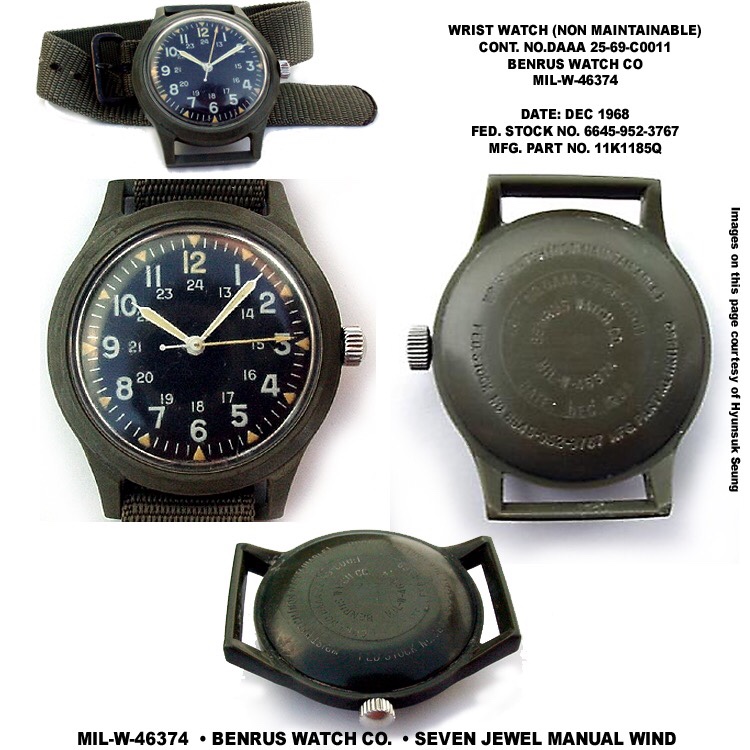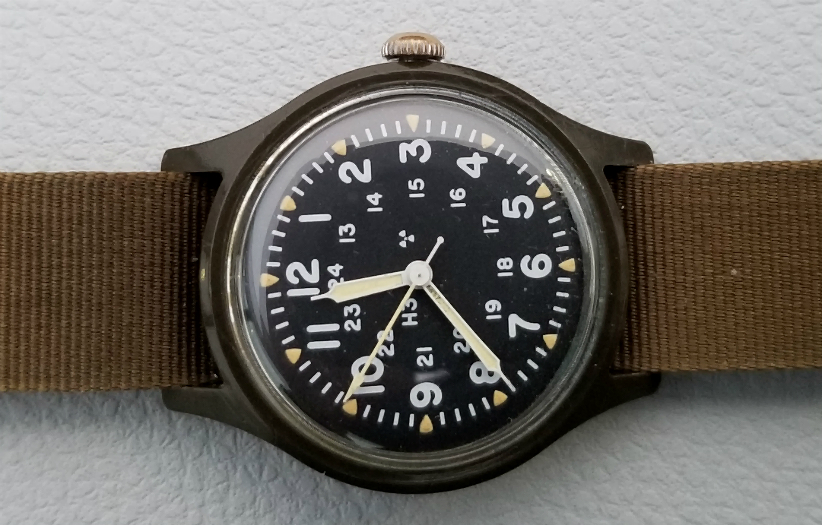TIMEX MIL-W-46374B, February 1982
Very rare watches that were created as part of a bid for a US military supply contract. Considerable mystique surrounds these. I will attempt as best as I can to describe all I know.
Hi, this is Alan. Thanks for reading, and for your interest in these reviews. My email. Other contact information is at the bottom of the page. Here is a really special Timex watch, a very rare watch that was part of a testing/approval process that saw Timex engaging with the US government (Department of Defense) in order to potentially win a contract to manufacture watches to be issued to soldiers.
This will be a sort of longer than usual review. You could say that it's kind of my white paper on this watch.
Pictured above is my watch. I purchased this in November, 2019. But I had one before. Many years ago, probably around 2000 or 2001, I purchased one from an ebay auction with a very blurry photo and equally vague description. But it looked unusual, and they only wanted about five dollars. When I received it, I was shocked to see this watch marked Timex on the back, with all of the usual military contract information, but not a Benrus or a Hamilton, but a Timex. The folks over at the old "Military Watch Resource" / Broadarrow were not sure what to do with it. Many were amused. Frankly, it was kind of amusing to learn of this serious looking milwatch, but from Timex!
It appeared that at that time this watch was not at all a well-known military timepiece. My pictures were probably the earliest posted to the internet of this watch, and for many years were the go-to, until others surfaced and made their way to the internet. For reasons I can't really remember any more, I sold this first watch I had, maybe around 2008 or so.
This page will show pictures of both of these watches (one I no longer own,) as well as a few other pictures; unless stated, all photos are take by me, of my watches.
I will begin by showing photos taken in 2019 and early 2020 of the recent watch I obtained. After this, will be photos of the first watch that I owned, and then sold (which were taken around 2001 or so). I will clearly indicate when I move over to the "old"/first watch. [CORRECTION: there was no room for photos of the first watch I had, so I put them on another page for you to see!]
spacer for pic of side view watch with strap
The caseback is loaded with information. NSN refers to the National Stock Number. DLA refers to Defense Logistics Agency, and this must the DLA number for this watch. Date of manufacture, FEB 1982. MIL-W-48374 is the specification of the watch created by the DOD for any manufacturer wanting to comply with the requirements.
The original spec. was from 1964, and it underwent revisions. The Timex was operating under the "B" revision. There will be much more on this, but if you wish to learn more about these specifications, see here and here.
DISPOSE RAD WASTE is very interesting, and relates to the fact that this watch is radioactive, using tritiium to power the luminous dial and hands. The watch, which was designed to be thrown out (not repaired) when it stopped functioning, needed to be disposed of properly, as it was considered radioactive waste. This disposable/nonrepairable nature will be discussed later as well.
Here is a photo of the glowing dial and hands. It's kind of a misleading photo. It's a 100% real photo, but not taken in typical conditions. It was obtained by shining a bright LED flashlight into the face of the watch, removing the light, and then taking the picture a couple of seconds later. The light faded pretty quickly. The watch, as it is now in 2020 is essentially nonluminous from an ordinary functional point of view.
You can only get it to do this for brief period, with a super bright light. Why? Probably from combination of breakdown of the photoluminescent material in the paint, as well as radioactive decay. The watch is about 38 years old at the time of this writing in January 2020, which is close to 3 half-lives old (tritium half-life=12.5 years). So, the amount of radioactivity remaining is about 13% of the original 1982 amount.
Furthermore, there is often a breakdown over time of the "photoluminescent" material added to the paint. This material, not the radiation itself, is what glows. The photons from radiation decay interact with the photoluminescent material, raising its energy level, the extra energy is given off as visible light, and then the material returns to ground state. Zinc Oxides are often used a photoluminescent materials.
Notice how much of the seconds hand is painted, not just the tip. This, and everything about the watch, is based on the government requirements.
Side view. Watch is in pretty good condition. Minimal wear to the case. The hands, as often seen on these watches based on pictures I've seen, have slight discoloration near the post, for the minute hand. Crystal was good, and the dial in pretty good condition.
Though the watch is in really good shape, it was certainly worn and used by someone. A lot. Have a look at the crown. The "base metal" of the crown, brass, is showing through. There has been so much use of this crown that the chrome has mostly worn off, to reveal the underlying brass. You can see some of the remaining chrome. This does not happen overnight, but usually needs decades of use, to show this degree of brassing. It make this more fascinating, to me. That someone, somewhere, used this watch, a lot. Seller was from Germany, and he said he got it from someone in either Germany or Austria. Of course, I'll never learn the story of where this watch has been all these years...
I usually don't include the auction pictures in these pages, but here are the photos from the seller. I was about to go to bed one night in November 2019, when I decided to check watch listings on eBay. I was amazed to see this watch show up. It looked like the real-deal, and was listed as Buy-It-Now. Lucky find, I have to say.
Above is the auction page. Take a look at the four thumbnail pics. Three are his pictures, but the third pic with the white background are a montage of four pics I took of my own earlier version of this watch in 2001, that the seller grabbed from the internet! Haha, it's kind of ridiculously funny that I bought a second one of these where 18 yr-old pics of my first one was used to sell it. Is that called "recursive?" I'm not sure, but maybe the seller using my actual pics kind of destined the horologic gods to help me to find this other example of it, in late 2019.
And here is that internet photo of my watch. The montage was created by E. "Ned" Frederick, who had his page up for many years, on the MIL-W-46374B specifications. For some reason, his page is no longer available. See" "Images courtesy of Alan N." on the right side.
Close up view of the luminous dial and hands.
An en face view of the caseback markings. The case is a single piece of plastic. The back of the case cannot be removed. Everything is all one continuous piece of plastic/resin, in an olive green color. If you want to get to the movement, you must remove the front crystal, remove the crown and pop out everything from the front. Further below will be pics of the movement, and inside of the case, for watch #2.
end/
The strap I have it on was not original to the watch, but was borrowed from a 1980s Timex Camper Watch (a watch that was a direct "civilian"/retial offshoot of this watch.)
The fixed lugs makes this watch more practical. No springbars to worry about, just slip through the one-piece strap. No concern for springbar failure and loss of watch.
No photoshop or digital filtering, but just a pic using the red safety light from a darkroom, just for fun
Tritium, "H3" has one proton and two neutrons. Ordinary hydrogen (also called "protium") has just one proton. Another isotope of hydrogen, deuterium, has a proton and a neutron, and is sometimes called "heavy hydrogen." Neither deuterium nor protium are radioactive. Water, using deuterium as the hydrogen of H20, is called "heavy water," and is used in nuclear power plants as a coolant.
Sometimes a black and white photo can help to see the form and design, without color to influence your thoughts. Not that color isn't part of a design, but I mean more about shapes, contrasts, proportions, lines, etc. Above and below are same image, with b & w for the below image.
Detail of dial and hands. The triangle markers for for the 12, 3, 6, and 9 hours are isosceles triangles, and for all other hours markers, equilateral triangles are used. This is well shown in this picture, and surely was part of the specification.
The font/lettering for the numerals i interesting, "Thick," "rounded edges" are two non-professional ways I'd describe it, and I'm sure that would make typography experts cringe. According to the Wikipediat entry on the MIL-W-46374 spec, "It borrows elements from the super legible Futura and Gothic style fonts of the day," also being influenced by a previous MIL specification, the "MIL-C-18012A," which itself "borrowed heavily from the Grotesk fonts of the 1920s." Below are some examples. The first image is said to be Futura. The second one is a Grotesk font, of which there appears to be many versions.
I didn't specifically try to do a soft focus on the dial, but the camera must have just locked a sharp focus on the hands. I liked the effect, so kept the pic. Again, as in all of these luminous shots, obtained using a bright light to "saturate" the zinc oxide (or whatever is in there,) with energy, and then taking the pic as soon as light is removed to capture the release back of that energy as this greenish light. it is very fleeting.
History, background and circumstances surrounding this watch.
Here I will attempt, as best as I can, to describe all I know and have been able to find out about this watch, and the overall history or legacy of Timex's involvement with military watches for the US government. A lot has been written about this, and with an information vacuum, there are varying accounts.
It is worth noting that there appear to be no remaining records or official accounts or documents remaining at the Timex world headquarters in Connecticut, regarding any of the Timex military watch projects. No technical diagrams, letters, or other official communications between Timex and other entities about this. This is not necessarily surprising. Companies cannot retain all document about everything, indefinitely. and at some point they appear to have been purged. Whether or not any related documents exist at any of the involved branches of US Government is unknown. Furthermore, there does not appear to be any current employees of the Timex Corporation who have any information about these projects. There are scattered individuals who are older and retired from official work who may have some recollection of events and details, as well as younger people active in the watch business who have spoken to older people who may have had some anecdotal recollections, and have relayed some of this information.
What remains, therefore, are the watches themselves, as well as the bits and pieces of information that can be gleaned from these sources, in order to create the story of the Timex military watch projects.
I will do my best to provide a story as best as I am able to.
I wish to first mention that US TIME (the parent company that developed the Timex watch, which later was renamed the Timex Corporation) was active in behind-the-scenes contract work for the US military during WWII, providing fuse timers for bombs, so that they would explode at the correct time, as well as gyroscope-type devices to keep aircraft and guided missiles along their specified course.
This is important, in that it established that US TIME was already a long-term, and presumably trusted supplier of technology and equipment for the US military, and it would make sense that they would persevere in their efforts to continue product and technology development for military supply and contracts. So, it's not at all surprising that they made watches in a bid for the MIL-W- 46374 specification watches.
Above image is from a US TIME ad, 1954. It's not an ad to sell military gyroscopes, but it's trying to ride in on the "postwar optimism" of the early and mid 1950s, by reminding customers of ordinary Timex watches, that "we also made these super precision military devices, so if it's good enough for military, it should be good enough for an ordinary watch!" The "3 ounce brain" refers to a gyroscope.
The above ad shows what I believe is a Boeing B-52 Stratofortress long-range bomber. The below ad shows what is being described as a guided missile, from a different ad, also from 1954. This missile presumably has the same or similar 3 ounce brain gyroscope as the B-52.
I'm kind of digressing a bit from my core mission of this article, about the watch in question, but the ad copy above is pretty interesting. It's the ad that highlights the guided missile. If I'm reading this correctly, were there dreams that guided missiles would be used in peacetime to deliver mail from New York to LA in one hour? Was these the early dreams of autonomous drones, the "3 ounce brain, engineered to be tomorrow's pilot" ? Fascinating....
Finally, to wrap up the bit on these ads, if anyone wants to see what these devices looked like, the cropped ad above shows both the gyroscope, at the top, and the fuse timer at the bottom. These ads also showed the watches, and were aimed at the ordinary consumer of watches.
If you look through ads which ran during WWII, as well as many postwar ads, messages with companies showing themselves as contributing to support the war effort were extremely common, and likely were effective in creating positive impressions of their products. So, US TIME did not stand out at all with these kinds of ads.
So, let's get back to the MIL-W-46374 classification (of which my Timex is the second, or "B" revision. The intro to the Wikipedia entry, above, is worth a quick read for the basics. Notice this replaced an earlier specification, MIL-W-3818, and the hallmarks were:
1. Low cost.
2. Disposable ("non-maintainable" as sometimes appeared on casebacks). This was likely part of cost-containment. If it broke, it would likely be cheaper to just throw it out and replace it, than to repair it. These watches did not have a removable back and were never designed for anyone to repair them.
3. Accurate (but note that these these were intended for "rank and file" soldiers. This was essentially a "field watch," and the precision and accuracy needed for, say, a pilot, would not be met with these watches.)
4. Luminous
5. Waterproof/water resistant
6. No specific number of jewels required in the movement. I believe in previous specifications, there was a requirement for a minimum number of jewels in the movement. With no minimum for the MIL-W-46374, Timex was able submit a proposal for a zero-jewel watch, using the M24 movement.
Here, btw is that movement, M24.
Now, before I talk more about my watch, and the 1981-1982 trial watches for MIL-W-46374B by Timex Corp, I want to point out that US TIME made similar trial watches for the MIL-W-46374 specifications many years before 1982, as far back as ca. 1966-1968! Have a look at the above watch, and the below pic which is the caseback of the above watch. The pic is from Jersey Mo, at this website.
Notice, this watch, which is MIL-W-46374, not MIL-W_46374B, looks different from mine. Firstly the numeral 12 also is painted with luminous material, The hand luminous is green, not off-white. The hour and minute hands have horizontal struts or septations across them, whereas my B version has hands with a single, continuous open space for the luminous filler. The lettering for the numeral is different. Finally, no H3 or radhaz symbols on the dial (those were not required until the B revision.)
Now, very interestingly, see the back of the case, below. You'll see it's MIL-W-46374. Not the B version. Not even the A version which came out in 1968. Also, instead of saying TIMEX CORP on the back like mine, it has THE UNITED STATES TIME CORP, which was the earlier name of the company (until changed to The Timex Corporation in July 1969).
So, as mentioned in the Wiki entry for MIL-W-46374, the specification was published in 1964. We know that the first revision, A, was in 1968 (month unknown). Therefore this original, unrevised MIL-W-46374 prototype would have came out in 1968 at the latest. Given that the first known watch from any company with the MIL-W-46374 was a "Belaforte" in 1965, I will give the approximate date of this sample/prototype watch, likely the first attempt at MIL-W-46374 by US TIME/TIMEX, as "1966-1968. This is 14-16 years before 1982. As rare as the 1981-1982 MIL-W-46374B Timex is, this 1960s prototype appears to be excruciatingly rare.
It is a very important watch, as it shows that Timex had tried as far back as then to make a "field" watch for the US military based on the MIL-W-46374. Where that project went, how many watches were made, any further details, I have no more info.
Notice that some details on the back of this prototype have not been filled in, including Contract Number, Date, and Federal Stock Number. I assume these were deliberately left blank, and if US TIME were to enter into a contract for full-scale production of the watch, then the final versions would have the correct information filled in on the final, approved watches.
For comparison, see my FEB 1982 caseback, below.
It's pretty clear that this 1960s Timex prototype never really went anywhere, as far as any kind of contract with the DoD to make the watch. I saw this because if it was made in large numbers, then we'd see it at least occasionally, if not frequently. Instead of "almost never," as is the case.
Why did a military contract never happen with that 1960s Timex? Was it because the DoD rejected the watch, for whatever reason or reasons? Or did the watch itself get approved, but maybe there was some kind of breakdown in the negotiations of the contract? Or did Timex decide not to pursue it, for whatever reason, in spite of approval. I don't have any of these answers.
I can say that other companies were making watches to the same specifications during this era, and maybe they were working out fine with the DoD and they didn't want to change anything. Below are some of these watches.
Above, not a Timex. This is a Belforte watch, from August, 1965, only 10 months after the specification was released in October 1964. This was likely the very first of the MIL-W-46374 watches made by any company. "Belforte," named after a town in France, was a sub-brand of Benrus.
The US rapidly increased military forces in South Vietnam during 1965; they began bombing North Vietnam in March 1965.
Above and below. Not Timex, but by Westclox, for the MIL-W-46374. December 1967.
The last non-Timex MIL-W-46374 I will show is the above Benrus, 1968. The pictures are from Hyunsuk Seung in Seoul, the montage is by Ned, from his seemingly now defunct earthlink.net site.
Ok, let's get back to this Timex! Above, another pic of my beautiful 1982 MIL-W-46374B Timex.
So, do we know if anything else happened between Timex and the DoD, with respect to the MIL-W-46374, between the late 1960s, and 1981-1982? If there was anything, I don't know of it. I can't conclude, of course, that there wasn't, but I have seen or heard no evidence of it.
So then, what happened with this, in the 1980s.
As best as I can tell, this is what happened.
1. Timex must have decided to have another go at a DoD bid for a MIL-W-46374 watch contract.
2. By this point, the MIL-W-46374 was on its second revision, the B revision (1975,) and the spec was therefore MIL-W-46374B.
3. Timex produced some watches that were dated on the caseback NOVEMBER 1981.
4. These sampled were submitted to the DoD for approval.
5. The watch sampled were not approved for a military contract. Whether they rejected them outright, or suggested to Timex that they could try to modify certain features, and resubmit additional samples, is uncertain, but I believe the latter, because:
6. Timex went back to the drawing board to revise their sample watches.
7. More trial/sample watches were manufacture. These had their backs stamped FEB 1982 and MAR 1982. (It seems to me that there are more out there with FEB, but the sample size is so small, that it's kind of hard to tell.)
8. One source I have contacted believes that there were about "only a couple of hundred" of the watches produced.
9. Times did win approval from the DoD for the revises FEB/MAR versions.
10. However, in spite of winning approval, certain circumstances led Timex to decide not the pursue the approved watch, and they never entered into a DoD contract for large-scale production.
11. Exactly what set of circumstances led Timex to make this decision is unknown to me. I'm not an expert in business, but I would imagine that in situations like this, the grand totality of a project is considered, and in the end, it could be said that "it was a business decision."
Have a look at the above email, from March 2002. In response to my question about an "unusual watch," the curator of the Timexpo Museum, Carl Rossa gave an explanation. The unusual watch was the first of the Timex MIL-W-46374B I had, which I later sold. Here, Mr Rosa suggests that was a combination of the exacting standards and costs that led them to "no longer pursue military approval." (Note: the Timexpo Museum closed on September 30th, 2015, just 14 years after opening.)
I am running out of allowable space for a single Homestead page! Wow, this is long. But there is a lot to cover. So, i'll leave you with links to learn more:
1. FIRSTLY, I promised I'd show pics of the first of these I bought back in 2001 or so. Since no room left on this page, I've made a special page of that first watch I had. Click this link!
2. November 1981 MIL-W-46374B that is housed at the Timex HQ in Connecticut, which looks really different from all others of this I've seen!
3. Mechanical "Camper Watch," began in 1983, the commercial offshoot of the MIL-W-46374 watches.
4. Very early 1983 version of Camper Watch.
5, Italian magazine ad for Camper Watch, 1983.
6. Total disassembly of a 1985 Camper Watch.
7. The Original Camper, a 2015 quartz revival of the mechanical original, by Timex in Japan.
8. Rare1968 "Fun Timer" watch, with a red resin case like the 1960s MIL-W-46374 prototype. If you're interested in the military Timex, you really should see this wild-looking watch!
Thank you so much for reading this very long article. I wanted to cover this in as great a detail as I know, and it came out necessarily long.. If anyone has more info on this, please share with me!
Thank you for reading. I hope you will like it.
Alan. CONTACT, 3 methods:
